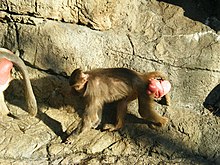
Sexual swelling, sexual skin, or anogenital tumescence refers to localized engorgement of the anus and vulva region of some female primates that vary in size over the course of the menstrual cycle.[1][2][3] Thought to be an honest signal of fertility,[4] male primates are attracted to these swellings; preferring, and competing for, females with the largest swellings.[5]
Though heavily investigated, the ultimate function of sexual swellings remains unknown.[6][7] Over the last 50 years, eight principal explanations have been proposed, each claiming to account for the function of exaggerated swellings. Alone, however, no single hypothesis is believed to account for the function of sexual swellings; a combination of these theories may be more appropriate.[8] In line with this ideal, the most recent account regarding the function of sexual swellings (the graded-signals hypothesis) combines several existing theories in the attempt to provide a more comprehensive account of sexual swellings.[9]
- ^ Deschner, T.; Heistermann, M.; Hodges, K.; Boesch, C. (2004). "Female sexual swelling size, timing of ovulation, and male behavior in wild West African chimpanzees". Hormones and Behavior. 46 (2): 204–215. doi:10.1016/j.yhbeh.2004.03.013. PMID 15256310. S2CID 37426597.
- ^ Nadler, R. D.; Dahl, J. F.; Collins, D. C.; Gould, K. G. (October 1, 1992). "Hormone Levels and Anogenital Swelling of Female Chimpanzees as a Function of Estrogen Dosage in a Combined Oral Contraceptive". Experimental Biology and Medicine. 201 (1): 73–79. doi:10.3181/00379727-201-43482. PMID 1528911. S2CID 36313842.
- ^ "Primate Factsheets – Glossary". Wisconsin National Primate Research Center. Retrieved 2023-03-11.
- ^ Brauch, Katrin; Pfefferle, Dana; Hodges, Keith; Möhle, Ulrike; Fischer, Julia; Heistermann, Michael (2007-09-01). "Female sexual behavior and sexual swelling size as potential cues for males to discern the female fertile phase in free-ranging Barbary macaques (Macaca sylvanus) of Gibraltar". Hormones and Behavior. 52 (3): 375–383. doi:10.1016/j.yhbeh.2007.06.001. PMID 17644098. S2CID 30650507.
- ^ Cite error: The named reference
:8was invoked but never defined (see the help page). - ^ Cite error: The named reference
:03was invoked but never defined (see the help page). - ^ ADVANCES IN THE STUDY OF BEHAVIOR. Academic Press. 1983-09-22. ISBN 9780080582740.
- ^ Cite error: The named reference
:14was invoked but never defined (see the help page). - ^ Cite error: The named reference
:04was invoked but never defined (see the help page).